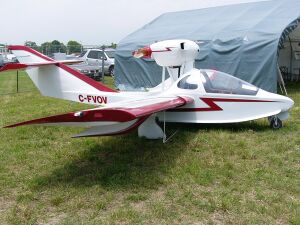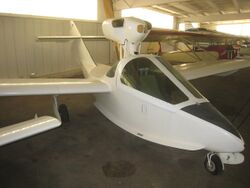Engineering:Osprey Osprey 2
| Osprey 2 | |
|---|---|

| |
| Role | Sport amphibian |
| National origin | United States |
| Manufacturer | Homebuilt |
| Designer | George Pereira |
| First flight | April 1973 |
| Status | Plans available (2015) |
| Number built | 500+ (2009)[1] |
The Osprey Osprey 2, also known as the Pereira Osprey 2 after its designer, is an amphibious sport aircraft designed for homebuilding.[2] Plans have been sold since the mid-1970s. George Pereira designed the Osprey 2 to address the two most frequent criticisms of his Osprey I aircraft: its lack of a passenger seat and its inability to operate from dry land.[3] An exercise that began as a series of modifications to the original design in January 1972 eventually turned into a complete redesign of the aircraft,[3][4] with the resulting Osprey 2 flying in April 1973.
Design and development
Like the original Osprey, the Osprey 2 is a mid-wing cantilever monoplane with a flying boat hull and a single engine mounted pusher-fashion in a nacelle mounted above the fuselage on struts.[4] A passenger seat is provided side-by-side with the pilot and the cabin is fully enclosed.[4] Retractable tricycle undercarriage is provided for land operations, the main units of which fold into the undersides of the wings.[3][4] Construction throughout is of wood and skinned in plywood.[3] Some of the hull contours are formed with polyurethane foam covered in fiberglass.[4][5][6]
The aircraft is designed so that it may be constructed by amateur builders with restricted space available – Pereira's prototype was built in a workspace 16 ft × 26 ft (4.8 m × 7.9 m) and took 1,300 hours to complete.[3] To simplify construction, no molds are required, and even the canopy is formed by a simple bend in an acrylic sheet without any compound curves.[7]
Osprey markets the aircraft as sets of plans rather than kits, and had sold over 1,000 copies by 1985.[1][4] Over 500 examples have been completed and flown.[8]
Aircraft on display
Specifications
Data from jane's All the World's Aircraft 1985–86, p.606
General characteristics
- Crew: One pilot
- Capacity: 1 passenger
- Length: 20 ft 6 in (6.25 m)
- Wingspan: 26 ft 0 in (7.92 m)
- Height: 6 ft 0 in (1.83 m)
- Wing area: 130 sq ft (12.0 m2)
- Empty weight: 970 lb (440 kg)
- Gross weight: 1,560 lb (707 kg)
- Powerplant: 1 × Lycoming O-320 , 150 hp (112 kW)
Performance
- Cruise speed: 130 mph (209 km/h, 110 kn)
- Range: 500 mi (800 km, 430 nmi)
- Rate of climb: 1,000 ft/min (5.1 m/s)
See also
Aircraft of comparable role, configuration and era
Related lists
Notes
- ↑ 1.0 1.1 Osprey Aircraft Website
- ↑ Taylor 1989, p.714
- ↑ 3.0 3.1 3.2 3.3 3.4 Markowski 1979, p.220
- ↑ 4.0 4.1 4.2 4.3 4.4 4.5 Jane's All the World's Aircraft 1985–86, p.606
- ↑ Markowski 1979, p.223
- ↑ Tacke, Willi; Marino Boric; et al: World Directory of Light Aviation 2015–16, page 120. Flying Pages Europe SARL, 2015. ISSN 1368-485X
- ↑ Markowski 1979, p.224
- ↑ Bayerl, Robby; Martin Berkemeier; et al: World Directory of Leisure Aviation 2011–12, page 114. WDLA UK, Lancaster UK, 2011. ISSN 1368-485X
- ↑ AirVenture Museum website
- ↑ "Pereira Osprey 2". http://pimaair.org/museum-aircraft/pereira-osprey. Retrieved 3 November 2020.
- ↑ "Airframe Dossier - Pereira GP3 Osprey 2, c/n GP3, c/r N3GP". http://www.aerialvisuals.ca/AirframeDossier.php?Serial=222112. Retrieved 3 November 2020.
References
- Jane's All the World's Aircraft 1985–86. London: Jane's Publishing. 1985. ISBN 9780710608215. https://archive.org/details/janesfightingshi8586shar.
- Markowski, Michael (1979). The Encyclopedia of Homebuilt Aircraft. Blue Ridge Summit: TAB Books.
- "Osprey II". Osprey Aircraft website. http://www.ospreyaircraft.net/osprey.htm. Retrieved 2008-12-28.
- "Pereira/Hummel Model 2 Osprey 2". Pima Air & Space Museum website. http://www.pimaair.org/collection-detail.php?cid=221. Retrieved 2008-12-28.
- "Pereira/Schifferer Osprey II – N346JS". AirVenture Museum website. http://www.airventuremuseum.org/collection/aircraft/Pereira-Schifferer%20Osprey%20II.asp. Retrieved 2008-12-28.
- Taylor, Michael J. H. (1989). Jane's Encyclopedia of Aviation. London: Studio Editions.
 |


